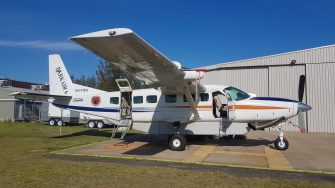
Date: Tuesday, October 2, 2018
Project: Eastern Australian Waterbird Survey
Observers: Richard Kingsford
Out of Bankstown airport for aerial survey 36 – every year for more than three decades we have been counting the waterbirds of eastern Australia for the governments and communities looking after our rivers and wetlands. Waved goodbye to Sydney.
This year we are in a larger aeroplane – a Cessna Caravan or 208. It can take 10 passengers with all the seats in. Our new National Parks pilot Tim was all set to go at 7am but it took us a couple of hours to hook up all the GPS equipment and Gopros on the wings and load everything into the plane. Stuart Halse, an old friend and colleague had come across from Western Australia to fly with us. He has a wealth of experience.
The new plane is larger and goes much faster but can also be slowed down for the aerial survey work. I was a little concerned about how it would feel after more than 30 years in small Cessnas. Apart from the speed between wetlands, this plane is also great for training new observers.
It wasn’t long before we were up surveying windy Myall lakes. Maybe it’s just the new plane but it seemed more stable in the wind that was whipping up streaks of waves on the surface of the lakes.
Surveying Myall Lakes, mostly counting swans and great cormorants.
There are always lots of swans, great cormorants and large pied cormorants here, peppered with the odd great egret. Nothing very new. I thought we might see more ducks with the big dry inland. But not one.
A quick stop at Port Macquarie to refuel and then on. From here we fly along the Bellinger River.
Surveying along the Bellinger River.
We are flying across the eastern most part of our 30km wide survey bands which stretch from the Whitsundays to south of Melbourne and across to the Northern Territory border. There are ten of them. So today, heading north, we surveyed Band 4 (Myall Lakes), Band 5 (Bellinger River at Uranga) and Band 6, just north of Byron Bay. Along the way, flying up the coast, there were three or four pods of humpback whales heading south.
Very little in the way of waterbirds on Bands 5 and 6, which is not unexpected because there are only a few minor wetlands on these parts of the survey bands. After Band 6, we had to drop into the Gold Coast to pick up a new radio before flying over Stradbroke Island to overnight in Maroochydore.
